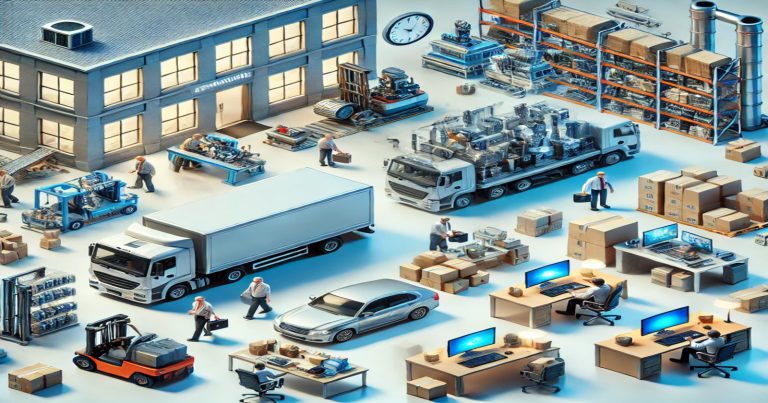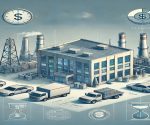Tangible assets examples have a physical presence like buildings, machinery, and vehicles. Every business relies on these assets heavily. They reflect a company’s resilience and assist financial planning. So, what is a tangible asset? It is an actual material that you can perceive and feel. It is useful and useful to run a business. In accounting, tangible assets include land, tools, furniture and stock. Such resources aid in everyday business operations. They enhance the company’s value and facilitate future expansion. For one thing, tangible assets can be counted and tracked. They are distinct from intangible assets such as brand name or goodwill. It is easy to measure tangible items.
What are Tangible Assets?
The tangible assets are the physical items owned by the company. They assist a business to function every day to generate earnings. This is machines, buildings, land, and stock. Physical assets gauged by daily work performed by companies. These assets are intrinsically propped in rupees. They can be bought or sold by businesses. You can find them juxtaposed on balance sheets.
How Tangible Assets Work in Business?
Physical assets play a major role in taking loans. In the event a company enters a payment default, it is better to have payment “insurance“. These also indicate whether a company is strong or weak. In the same way, a factory with lots of trucks, land, and buildings would be more trusted than a factory with none.
Below are the key attributes of tangible assets:
- You can touch them
- They have a real value
- You use them daily in work
- You can sell them
Tangible assets are divided into two parts — current and non-current. This means that they are current because they roll in one year. The word non-current indicates that they remain for a long time, literally for years. Let’s explore each.
Tangible Assets Examples and Intangible Assets Examples
Assets, both tangible and intangible, are integral components of every business. Intangible assets are not physical, and tangible assets can be touched. Both types of financing help companies grow and demonstrate their value. There are two types of company assets, tangible and intangible. You should know the difference.
Tangible Assets
Tangible assets are the ones you can see and touch. Tangible items are things a company owns and uses. Land, machines, buildings, and vehicles. They are valuable and help to enable day-to-day business and growth. They include:
- Land
- Buildings
- Machinery
- Office furniture
- Tools
- Stock/inventory
- Vehicles
Intangible Assets
Intangible assets are assets you can’t touch. Intangible assets refer to non-physical assets that increase the worth of a company. Such as goodwill, patents, trademarks, and brand reputation. It is intangible but contributes positively to long-term success. They include:
- Patents
- Trademarks
- Copyrights
- Software
- Goodwill
- Brand value
What are tangible assets, people often ask — Patents, trademarks and franchises are tangible assets? The answer is no. You cannot touch them so they are not tangible. Both types are very useful. However, when it comes to work done for monetary purposes, concrete ones gain more prominence as they represent a true form of value. Investors feel more secure when they see physical assets in a company.
Real World Tangible Assets Examples with Meaning
Tangible assets that can be found in the real world are objects that businesses utilize on a daily basis to conduct their operations and make money. Balance Sheet of Property, Plant and Equipment: Land, buildings, tools, vehicles, and inventory. They are concrete, visible, tangible and quantifiable.” All of them affect how a business operates and scales. While giving more facts on accounting along with real-life instances, practical use of these concepts can be proved in the path of Student and Professionals. Now, let us detail key tangible assets examples one by one.
Land
Land might be one of the most common tangible assets. It refers to the physical premises of a company. Land is a type of tangible asset that a business owns for long-term use. It is physical, has value, and does not wear out like other assets. Land is often recorded at cost and not depreciated.
For Example: There is a school, which has 5 acres of land in Delhi, where they develop classrooms and playgrounds. That land sustains them as they operate their school.
Use:
- You can build on it.
- You can rent it.
- You will be able to sell it later on.
Accounting Note: Land has no depreciation. Its value tends to go up over time.
Buildings
A building is a tangible asset used for business operations like offices, factories, or warehouses. It is a long-term physical asset with a measurable value. Buildings are depreciated over their useful life. Buildings are consisting of offices/factory/store/showroom
For instance, a company such as Flipkart owns large warehouses. These are places that stores are used to store the products.
Use:
- They provide working space.
- They store goods.
- They aid in seamless business operations.
Accounting Note: Buildings depreciate over time because of wear and tear. This is called depreciation.
Machinery and Equipment
Machinery and equipment are tangible assets used in production or daily business tasks. They help in creating goods or providing services. These assets lose value over time and are depreciated regularly. Machines and tools used in a factory or workshop.
Eg: A company that manufactures biscuits has large machines to bake and package biscuits. These are examples of tangible fixed assets.
Use:
- Makes production faster.
- Saves manpower.
- Generates profit as output.
Accounting Note: They got a set value and depreciate every year.
Vehicles
Vehicles are tangible assets used for business transport like delivery or travel. They are physical, long-term assets with measurable value. Vehicles are depreciated based on usage and time. Non-lease vehicles owned by the company used for business purposes (trucks, delivery van, etc.).
For instance, Zomato owns a fleet of delivery bikes. These are tangible assets since they assist in daily food deliveries.
Use:
- Used for logistics
- Saves time
- Serves customers
Accounting Note: a vehicle loses value every year it is used (depreciation).
Furniture and Fixtures
Furniture and fixtures are tangible assets used to support daily business activities. Items like chairs, desks, and lighting systems fall under this category. These assets are depreciated over their useful life. This covers tables, chairs, cupboards, light fittings and fans in the office or shop.
For example, an office of a startup with chairs and desks for employees. Those are small but common and very needed examples of tangible belongings in accounting.
Use:
- Improves the working environment.
- Helps in smooth office setup.
Accounting Note: These also slowly depreciate over years.
Inventory (Stock)
Inventory, also called stock, is a tangible asset that includes goods a business holds for sale or production. It is short-term and directly linked to revenue. Inventory is valued and tracked regularly. This is merchandise for sale or raw materials.
As an example, a clothing shop has 500 shirts and 300 trousers in stock. This is currently hard asset like gold.
Use:
- Sold to customers.
- Helps in business income.
Accounting Note: Its changes frequently and then is the one recorded as the current asset.
Computers and Technology Hardware
Computers and technology hardware are tangible assets used in daily business operations. They include items like desktops, servers, and printers. These assets are depreciated over time based on their usage. Including desktops, laptops, servers, printers, etc.
Example: A digital marketing agency has 10 computers spent on designers and writers.
Use:
- For work output.
- Data processing and design.
- Communication.
Accounting Note: These lose value more quickly and require an update every 3–4 years.
Example of Tangible Fixed Assets
Tangible fixed assets are material goods held for long-term use by a company. These would not be changed as quickly as stock. They assist in producing goods or services that will operate for years. Tangible, long-term fixed assets are the physical items a business uses for years and provided that it is an item or object still in use, continues to provide value. They assist in the production or delivery of a service, and are not intended for immediate sale.
Most Common Tangible Fixed Assets
The most common tangible fixed assets are physical items that companies use to conduct business over the long term. These materials support daily operations, production, and service provision. They stick around the company for years and are worth money in the long run. You can also look at an example of tangible fixed assets.
- Factory land and buildings
- Heavy machinery
- Office computers
- Delivery trucks
- Store furniture
These are not sold quickly. They are with the business for 5–10 years plus. A business reuses them over and over again. They are not available for customers to buy.
Real-World Use
Let’s take an example. A company called “Sharma Textiles” buys 10 weaving machines. Each costs ₹5 lakh. These machines are maintained for a period of 7 years. These are examples of tangible assets because:
- You can touch them.
- They allow the company to produce its cloth.
- They last many years.
- They hold value.
So, these are physical, tangible fixed Asset and non-current assets.
Examples of Tangible Assets in Accounting
Tangible assets in accounting are recorded as physical items that have value and help a business function. These are included in the company’s balance sheet and are critical for analyzing the company’s financials. This includes things like machinery, land, vehicles, and furniture. All of them have a direct impact on the ability of the company to manufacture goods or perform a service. These examples of tangible assets in accounting good because it teaches us how business displays the real value to the financial bites. A tangible asset is anything that exists physically, and this is reported on the balance sheet in accounting. These assets give you insight into just how strong the company is.
Key Tangible Assets in Accounting
The value of these assets is written down annually by accountants. This is called depreciation. It tells you how much value you lose because of the age of the object. So if you have spent ₹50,000 on a computer and are using it for 5 years, your loss in value will be ₹10,000 every year. Now, let us look at some examples of physical assets in accounting:
| Asset Type | Example | Category |
| Property | Office Building | Fixed Asset |
| Equipment | Printing Machine | Fixed Asset |
| Vehicles | Delivery Van | Fixed Asset |
| Inventory | Readymade shirts in stock | Current Asset |
| Furniture | Office Chairs | Fixed Asset |
| Tools | Construction Tools | Fixed Asset |
Net Tangible Assets Calculation Example
The net tangible assets represent the true value of the company. You then take the total assets and subtract all debts and non-physical assets. The true value of a company is revealed by net tangible assets, which subtracts debt plus non-physical assets from the total. It reveals how much the company owns in real, tangible assets after settling all obligations. This value allows investors and lenders to assess a company’s financial strength. Realizing how companies analyze their real value in accounting is easy when you are aware of a net tangible assets calculation example.
Formula for Net Tangible Assets
The formula is:
Net Tangible Assets= Total Assets—Intangible Assets—Liabilities
Here’s a simple example of a net tangible assets calculation:
- Total assets = ₹50,00,000
- Intangibles (e.g., patents) = ₹5,00,000
- Liabilities = ₹15,00,000
So,
Net Tangible Assets =₹50,00,000−₹5,00,000−₹15,00,000=₹30,00,000
This is the amount that we see the real value of a company when it sells all physical things and pays all loans. This is the value which investors use prior to purchasing shares.
Example of Tangible Non-Current Assets
Non-Current Assets: physical things owned by the firm and utilized for more than 1 year These assets will help operations in long term and will not be sold immediately. They are, for example, land, buildings, and heavy machinery. Let’s compare another example of the tangible non-current assets which make part of the non current assets definition. Tangible assets are non-current if they are held by the company for more than one year. These are long-term assets.
Tangible Non Current Asset Examples
These assets trade infrequently. They help in the long run. The assets side of the balance sheet under non-current shows you how they are phrased. So if “Bajaj Foods Pvt Ltd” has a land of 2-acre, and they maintain it for their production plant, that will be a physical non-current asset. These are instrumental in making products, providing services and making money every year. Example of tangible non current assets are as follows:
- Manufacturing machines
- Buildings
- Land
- Company vehicles
- Office setups
Relevance to ACCA Syllabus
The testing of the tangible assets is done in subjects like FA (Financial Accounting), FR (Financial Reporting), and SBR (Strategic Business Reporting) of ACCA. Similarly, knowing about tangible versus intangible assets, the accounting treatment along with depreciation is very critical.
Tangible Assets Examples ACCA Questions
Q1: Physical Non-current assets are:
A. Software License
B. Inventory
C. Factory Building
D. Goodwill
Answer: C. Factory Building
Q2: Which section of the statement of financial position does tangible assets appear?
A. Current Liabilities
B. Non-current Liabilities
C. Non-current Assets
D. Equity
Answer: C. Non-current Assets
Q3: From accounting perspective, which of the following is not a tangible asset?
A. Delivery Truck
B. Land
C. Brand Value
D. Office Furniture
Answer: C. Brand Value
Q4: Generally depreciation will apply to:
A. Trade Receivables
B. Patents
C. Inventory
D. Machinery
Answer: D. Machinery
Q5: Which of the following would be classified as a tangible fixed asset?
A. Email Hosting Service
B. Trademark
C. Retail Store Building
D. Domain Name
Answer: C. Retail Store Building
Relevance to US CMA Questions
In US CMA Part 1: Financial Planning, Performance, and Analytics, candidates need to understand how tangible assets are measured, depreciated, and provided in capital investment analysis. They are also used for cost allocation and budgeting.
Tangible Assets Examples US CMA Questions
Q1: What is a physical thing used in production?
A. Customer List
B. Delivery Van
C. Brand Recognition
D. Prepaid Insurance
Ans: B. Delivery Van
Q2: The definition of a tangible asset is:
A. Something that possesses legal rights
B. A non-physical resource
C. A tangible item with a price tag
D. A contractual agreement
Answer: C. A tangible property with monetary value
Q3: Which of the following is NOT tangible fixed asset?
A. Equipment
B. Land
C. Logo Design
D. Office Furniture
Answer: C Logo Design
Q4: Depreciation expense is used to:
A. Increasing company cash
B. Valuing intangible assets
C. Spreading the cost of an asset over its useful life
D. Avoiding tax
Answer: C. Spreading cost of asset over how long it is useful for
Q5: The tangible asset with the fastest depreciation would likely be:
A. Land
B. Factory Building
C. Machinery
D. Office Chair
Answer: D. Office Chair
Relevance to US CPA Questions
FAR (Financial Accounting and Reporting) primarily concerns itself with Tangible assets. Under US CPA, candidates should be able to apply methods of depreciation, disposal of assets, and identify tangible and intangible fixed assets.
Tangible Assets Examples US CPA Questions
Q1: Which of the following is amortized over time in accounting?
A. Inventory
B. Office Desk
C. Brand Name
D. Goodwill
Answer: B: Office Desk
Q2: Under U.S. GAAP, land is classified as a:
A. Tangible Current Asset
B. Tangible Non-current Asset
C. Intangible Fixed Asset
D. Current Liability
ANSWER: B. Tangible Non-current Asset
Q3: The difference between tangible and intangible assets is:
A. Tangible assets are the only things of value
B. Depreciation can run only for intangible assets
C. Tangible assets occupy physical space
D. Intangible Assets are visible Only in cash flow
Answer: C Tangible assets are tangible
Q4: Which of the following is not classified as a tangible asset according to GAAP?
A. Warehouse
B. Forklift
C. Software License
D. Inventory
Answer: C. Software license
Q5: How is depreciation reflected in the statement of financial performance?
A. As a liability
B. As an expense on the income statement
C. As goodwill
D. As an intangible asset
Answer: B. An expense in the income statement
Relevance to CFA Syllabus
It is part of CFA students’ Level I: Financial Reporting and Analysis curriculum where they learn how the use of tangible assets impacts return ratios, earnings quality and company valuation. Getting classification right and impact right on financial metrics are critical
Tangible Assets Examples CFA Questions
Q1: Tangible assets are more likely to be categorized as:
A. Items with value that are not physical
B. Physical long-term operating resources
C. Debt instruments
D. Liquid financial holdings
Answer: B. Physical long-term operating resources
Q2: Tangibles allow analysts to know:
A. Tax policy
B. Return on assets
C. Interest rates
D. Foreign exchange rates
Answer: B. Return on assets
Q3: Owning large tangible assets has important financial implications.
A. Lower asset turnover
B. Accumulation of intangible capital
C. Reduction in liabilities
D. Higher inventory levels
Answer: A. Asset turnover is lower
Q4: In financial models, analysts account for depreciation to:
A. Inflate revenue
B. Reflect asset usage
C. Hide expenses
D. Avoid taxes
Answer: B. Reflect asset usage
Q5: High worth in tangible assets in ratio analysis usually suggests:
A. Higher liquidity
B. Fixed asset intensity is more important
C. Lower profit margins
D. High amount of working capital turnover
Answer: B. Higher fixed asset intensity


